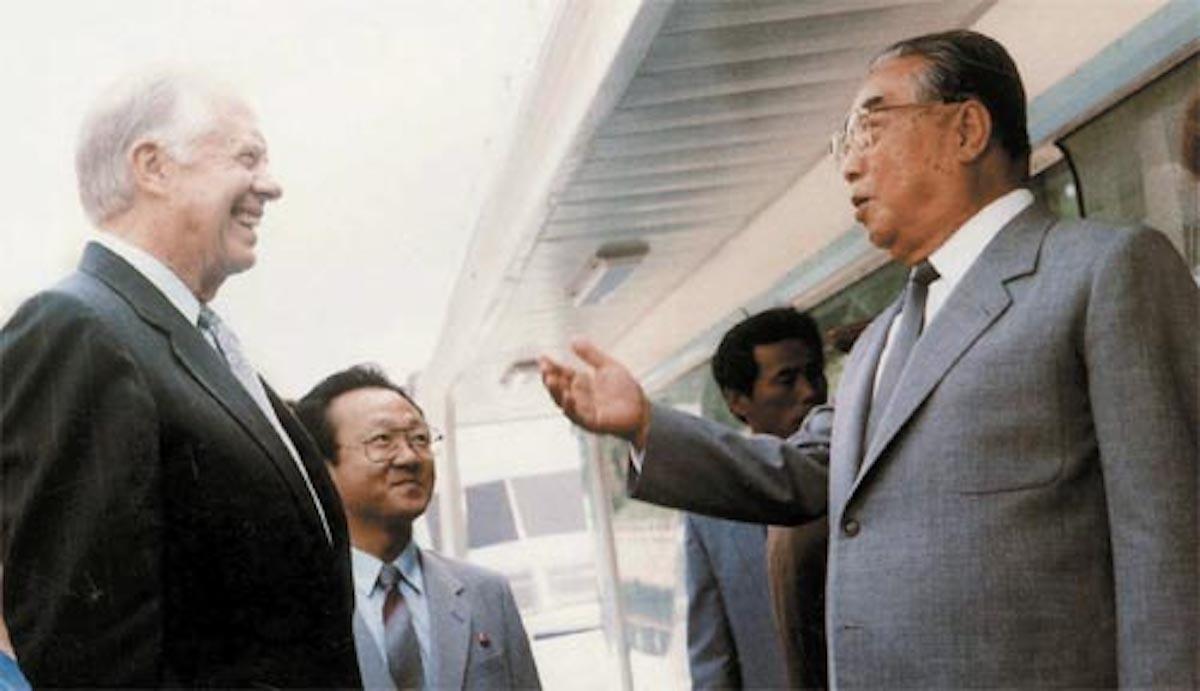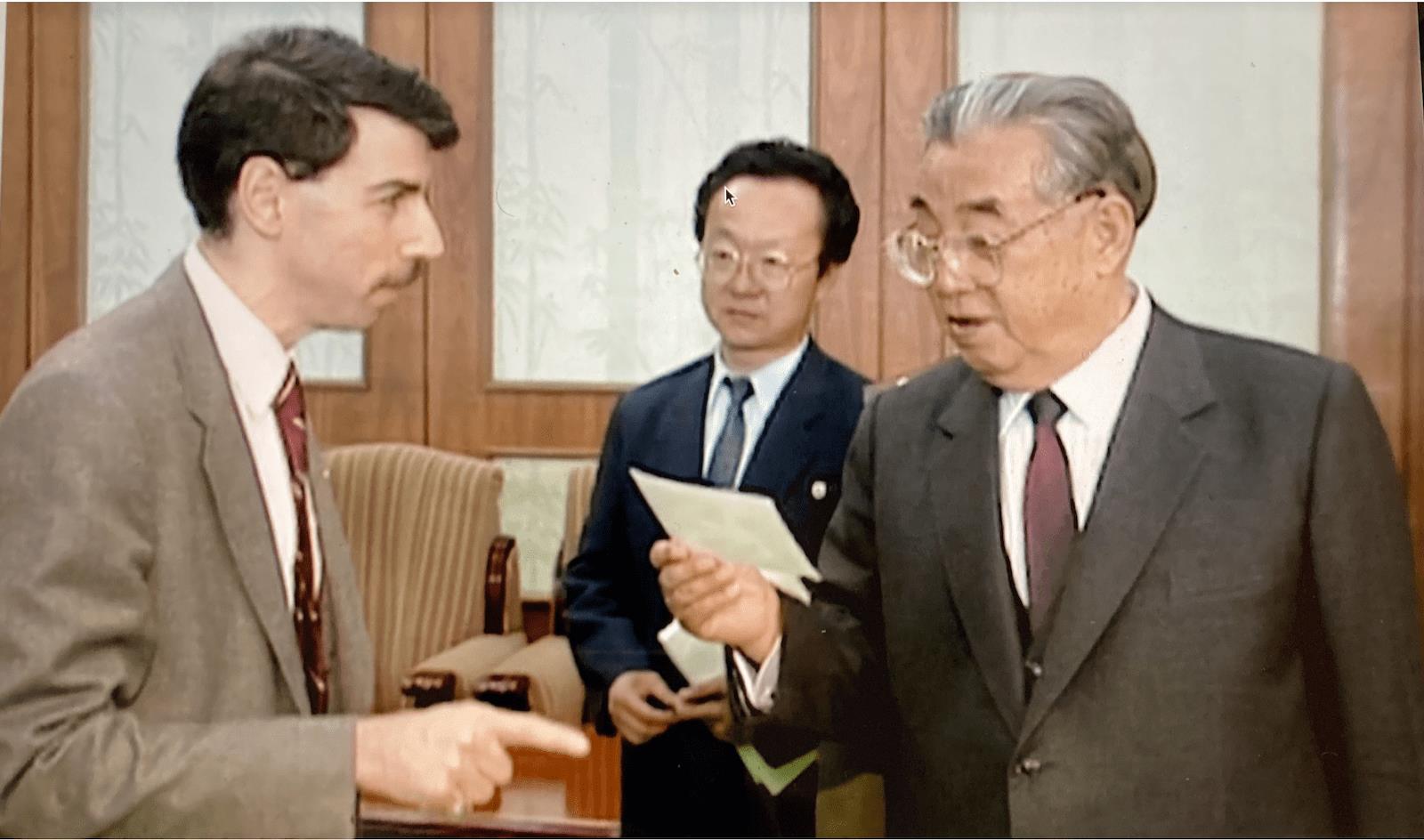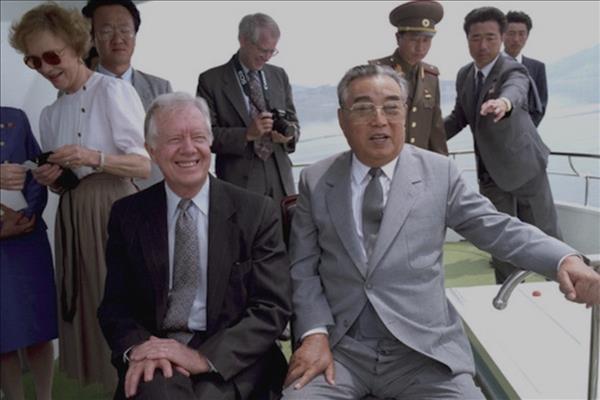(MENAFN- Asia Times) With his decision to leave the hospital for final hospice care at his Plains, Georgia, home, 98-year-old Jimmy Carter has ensured his living presence during a major chunk of his memorialization as the United States' longest-living and, post-White House, highest-achieving former president. Asia Times' contribution is this memory, shared with our readers by former longtime CNN correspondent Mike Chinoy. -Editors
On June 15, 1994, Jimmy Carter, his wife Rosalynn, and a handful of aides crossed the world's most volatile frontier. In a half century of tortured relations between Washington and Pyongyang, there had never been a scene like this: a former president of the United States setting foot in North Korea on a mission of peace against a backdrop of growing fears of war.
In the previous month, North Korea had announced its withdrawal from the Nuclear Non-Proliferation treaty, threatened to expel IAEA inspectors and begun removing 8,000 spent fuel rods from its Yongbyon nuclear reactor. US experts believed the rods, if reprocessed, would provide North Korea enough plutonium for four or five atomic bombs.
The administration of President Bill Clinton accelerated a drive for UN sanctions and began to beef up its military posture in South Korea. Pentagon planners examined options for taking out North Korea's nuclear capabilities. A second Korean war seemed a frighteningly real possibility.
Jimmy Carter's successful effort to defuse an exceptionally dangerous crisis remains one of his greatest achievements. I was CNN's Beijing bureau chief at the time, and my team and I were the only foreign journalists permitted to accompany Carter on his historic visit. CNN's access was the result of several previous trips, two of which had included meetings with Kim Il Sung.
The most recent had been in April 1994, when my crew and I had been allowed to accompany a group of foreign VIPs organized by the Reverend Sun Myung Moon's Reunification Church to mark Kim's 82nd birthday. We were able to videotape Kim's meeting with the group, in which he talked about the nuclear issue. Kim then hosted us for a memorable lunch, after which I did the first-ever live shot from North Korean TV and included clips of Kim's comments in my report.
The worldwide impact of that broadcast – at the time, CNN was the only TV network with global reach, and this was the first time the Great Leader had ever spoken for foreign television – appears to have been the key factor in Pyongyang's decision to grant CNN access for the Carter trip.
“My old friends!” Kim's gravelly voice boomed out across the vast reception hall of the cavernous Kumsusan Palace, as he held out his hand to greet us. Kim was in good humor, laughing and joking as cameraman Mitch Farkas shot video. Soon after, Carter arrived and, with our camera rolling, the two men warmly shook hands. My crew and I were then ushered out as Carter and Kim began their discussions.

Former US President Jimmy Carter, left, and then-North Korean leader Kim Il Sung talk during the former president's 1994 trip to the communist country to discuss its nuclear arms program. Photo: JoongAng Ilbo
From the outset, it was clear that Carter understood Kim Il Sung's almost desperate desire to be treated with respect by the United States.
That night, I finished my live report by noting that“North Korea for years has sought recognition and legitimacy from the United States. To have a former American president here is precisely the kind of gesture the North Koreans have been seeking. Whether that will translate into substantive progress on the nuclear issue, however, is another question.”
Returning to the Koryo Hotel, I found an urgent message from CNN International Editor Eason Jordan, who, along with cameraman Farkas, had accompanied Kim and Carter to a cultural performance, while producer Tim Schwarz and I had handled the transmission. Eason asked us to come to the Presidential Guest House immediately.
Moments after we arrived, Carter walked in, and we helped him get on the phone with CNN, where he told White House correspondent Wolf Blitzer that Kim Il Sung had pledged not to eject international inspectors from North Korea's nuclear facilities, and to allow continuing monitoring of the Yongbyon complex as long as“good faith efforts” were being made to resolve the crisis.
Describing the move as a positive step, Carter called on the Clinton administration to pull back from its sanctions drive and immediately open high-level talks with Pyongyang.
As I watched Carter announce the breakthrough via telephone on CNN, Clinton and his top national security aides were holding a council of war in the White House situation room, discussing the possibility of sending more troops, planes, and ships to South Korea, even considering a US air raid on the Yongbyon facility. As Carter spoke, the senior officials gathered around a TV set.
Many members of the administration had been uncomfortable with the Carter mission from the start, doubting the wisdom of any self-appointed emissary trying to engage Kim Il Sung while the US was seeking to mobilize world opinion for sanctions – and questioning in particular the suitability of a man who, as president, had often been labeled a weak and ineffective figure.
Now here he was, not only negotiating in public, but apparently securing concessions the administration had itself been unable to achieve. As one senior State Department official later told me,“It was humble pie in living color for Clinton. Through CNN, Carter had jammed the bureaucracy, and gave those arguing for restraint the ammunition they needed.”
The next morning, Eason Jordan and Mitch Farkas accompanied Carter as he went boating with Kim, while I appeared on“Larry King Live,” only to have King interrupt our conversation to do an update about O J Simpson. The North Korean leader took the former president on his official yacht, an opulent vessel with huge picture windows and an all-glass elevator, to continue their talks.
At mid-day, after the two men had spoken for more than three hours, Eason and Mitch returned to the hotel.“You won't believe what Carter told Kim,” Eason exclaimed.“He announced that the Americans had agreed to stop the sanctions push now. And we have the whole exchange on tape!”
I was astonished. The tape showed Carter stating,“I would like to inform you that they [the US government] have stopped the sanctions activity at the United Nations.”
Carter added that if the North Koreans froze their nuclear program, it was his understanding that the US was also willing to discuss helping North Korea acquire a light-water reactor, which would produce much less plutonium than the old, Soviet-model graphite-based reactors the North Koreans were currently using.
Suddenly, the elements of a compromise appeared to be taking shape. But our report on Carter's statement triggered a firestorm of controversy.
Moments after it aired, angry and embarrassed administration officials insisted that Carter was wrong, and that the US had not dropped its sanctions bid. A few hours later, a flustered-looking President Clinton made the same point in front of TV cameras.
Nonetheless, before leaving Pyongyang, Carter told me he was confident he had made major progress. And he reiterated the importance of direct dealings with Kim Il Sung.“You have to have direct communication with the only man in the country who can make a decision,” he insisted.
Carter and Kim in Pyongyang. Photo: Al Jazeera
The North Koreans were pleased as well. Before we set off for the TV station for our final transmission, a senior official on Kim Il Sung's staff, with great solemnity, gave each member of the CNN team a lapel button of the Great Leader.
“I better not wear this on air,” I joked to Eason Jordan.“There are probably a lot of people who already think we are dupes of the North Koreans just for being here.”
The next day, Carter arrived in Seoul with another bombshell – a proposal from Kim Il Sung for a face-to-face meeting with his arch-rival, South Korean president Kim Young-sam.
Had Carter not been able to convince the South Korean leader to agree, his whole mission risked failure. But the former president, using the same combination of sincerity, persistence and respect that he had employed in Pyongyang, was able to transform a suspicious and alarmed Kim Young-sam into a receptive and cooperative partner. Immediately after meeting Carter, the South Korean president accepted Kim Il Sung's offer of talks.
Confronted with a barrage of criticism for his on-air comments in Pyongyang, Carter backtracked on what he had said in our presence about sanctions, telling reporters that he was only expressing a“personal opinion” that the sanctions bid would be halted.“I regret the misunderstanding,” he announced.“It was my fault.”
But in fact, it seems clear Carter was playing a complicated game, seeking to circumvent what he viewed as a mistaken and dangerous US policy by pulling the elements of a nuclear deal together himself. He may well have misspoken, but it was equally possible that he was trying to“create his own reality,” deliberately exceeding administration guidelines to elicit more concessions from Kim Il Sung and buttress his case for a compromise solution.
It was here that CNN's role – the fact that Carter's statements were captured on camera and transmitted and broadcast almost instantaneously – changed the entire dynamic of diplomacy.
The whole world knew what Carter had said and done at the same time as the key policymakers in Washington and other capitals became aware of his actions. Detailed consultations were no longer possible before senior American and South Korean officials were forced to respond.
The result was that in the 48 hours immediately after our controversial broadcast, it was possible to see an almost hour-by-hour evolution in US policy towards North Korea taking place on CNN's air. As the impact of the concessions Carter had secured in Pyongyang sank in, the tone of officials from President Clinton on down shifted from calling for UN sanctions to welcoming new high-level negotiations.
For all the criticism of Carter's role, it quickly became clear that the former president's intervention had halted a dangerous slide toward confrontation.
Kim Il Sung died of a heart attack three weeks after the Carter visit. He was succeeded by his son, Kim Jong Il. But four months later, building on the momentum Carter had created, the US and North Korea signed an agreement in Geneva intended to pave the way for a peaceful resolution of the nuclear crisis.
Although it ultimately unraveled during the administration of George W Bush, the 1994 Agreed Framework did lead to a freeze in North Korea's plutonium program that lasted almost a decade, and to a slow thaw in relations that climaxed in Secretary of State Madeleine Albright's visit to Pyongyang in 2000 The shadow of war over the Korean peninsula – for a time, at least – receded.
Shortly after the Carter trip, I spoke with Danny Russel, then a diplomat specializing in North Korea at the US Embassy in Seoul and later President Barack Obama's assistant secretary of state for East Asia.“We were right at the edge of the cliff,” Russel told me.“We were really close to a war. Jimmy Carter saved us from that.”

The author meeting Kim Il Sung in 1992. Photo courtesy of Mike Chinoy
Mike Chinoy is a non-resident senior fellow at the University of Southern California's US-China Institute. He spent 24 years as a foreign correspondent for CNN and visited North Korea 17 times. He is the author of china live: people power and the television revolution , from which portions of this article are drawn, as well as meltdown: the inside story of the north korean nuclear crisis . His latest book is assignment china: an oral history of american journalists in the people's republic .





















Comments
No comment